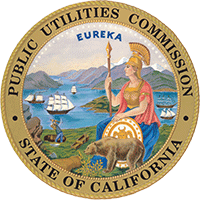CPUC Decision Makes California First State in the Nation To Allow Submetering of Electric Vehicles
The California Public Utilities Commission (CPUC) today made California the first state in the nation to allow electric vehicle (EV) owners to measure an EV’s energy use independently from the owner’s main utility meter through a technology known as submetering. This groundbreaking Decision will accelerate the growth of EVs by allowing EV drivers, owners of fleets of electric buses and trucks, and other customers to avoid installing an expensive additional meter for measuring the electricity used by charging their EVs.
Separately metering EV charging independently from a customer’s main utility meter is crucial because special rate structures apply to EVs that allow customers to buy less costly power during off-peak times. Those rate structures are often inappropriate for the entire home or commercial facility where the EVs are located. The inability to submeter has been a major barrier to the expansion of EVs because taking advantage of EV-specific rates significantly lowers the total cost of ownership of an EV but few customers are willing to invest in a separate utility-grade meter. Submetering will also allow EV charging to participate in demand response programs by decreasing the EV charging load or even feeding power back into the grid when it is needed most.
“Submetering makes EV charging cheaper and will help spur the growth of electric vehicles throughout the state,” said Commissioner Clifford Rechtschaffen, who is assigned to the proceeding. “It’s a practical solution to one of the important barriers to widespread EV adoption.”
“Taken together, the submetering and communication protocols enable customers to realize greater electric grid benefits by allowing them to optimize charging and to participate in programs such as demand response – for both their and the grid’s benefit,” said CPUC President Alice Busching Reynolds.
Today’s Decision also adopts communication protocols for EV chargers, which are often called EV Service Equipment (EVSE). The communication protocols are consistent with recent CPUC-approved utility EV programs, as well as with the California Energy Commission’s (CEC) recommendations for EVSE. The CEC has deemed these standards as vitally important to ensure interoperability with publicly funded EV charging infrastructure and to ensure the state achieves convenient, grid integrated charging.
Both aspects of today’s Decision are crucial to enable widespread Vehicle-Grid Integration (VGI) and to garner the resulting grid benefits. VGI refers to a suite of actions that shape vehicle charging behavior—such as changing the time or level of charging, or how power is sent back to the electric grid from vehicles—in ways that maximize both consumer and grid benefits. As the number of EVs in the state grows rapidly to meet our state’s climate goals, VGI will ensure that the electric grid is not stressed by the new load and will also allow customers to buy electricity at the cheapest times.
“The Decision outlines the tremendous amount of work that has taken place over the past several years to arrive at a point where customers and utilities can rely on the primary meter to provide electric vehicle submetering. The technology is available to have electric vehicle charging measured and billed separately without the utility having to install a separate meter,” said Commissioner Genevieve Shiroma.
California is the leader in electric cars with more than 1 million EVs sold in the state, comprising nearly half of nationwide EV sales. More than 16 percent of passenger cars now being sold in California are electric. Governor Gavin Newsom has advanced a historic $10 billion zero-emission vehicle (ZEV) package to accelerate this transition and make ZEVs more affordable and convenient for all Californians. To support the rapidly growing number of EVs, the CPUC has authorized utilities to spend more than $1.5 billion on EV charging. These funds are primarily dedicated to the EVSE, the supporting electrical equipment such as distribution lines, and the costs of installation. The CPUC has also directed utilities to create a menu of special rates for EV charging, making fueling EVs significantly cheaper than using gasoline or diesel.
The proposal voted on is available at docs.cpuc.ca.gov/PublishedDocs/Published/G000/M496/K405/496405751.PDF.
Documents related to the proceeding are available at apps.cpuc.ca.gov/p/R1812006.
The CPUC regulates services and utilities, protects consumers, safeguards the environment, and assures Californians’ access to safe and reliable utility infrastructure and services. For more information on the CPUC, please visit www.cpuc.ca.gov.
###
